This is better than that grizzly western in which everyone was lathered with chicken grease, and more spiritually resonant than The Road. (Well, how could it not be?) The narration sounds Terrence Malicky, obviously. The music is what finally makes it. Where’s it from?
Day: July 8, 2010
Stealth
A New York media guy who’s seen Phillip Noyce‘s Salt (Columbia, 7.23) says it “plays like gangbusters. It’s a thoroughly entertaining piece of popcorn that may very well launch a new franchise for Angelina Jolie (forget those horrible Tomb Raider abominations — this really is her Bourne).
“Clearly it’s more accessible than Inception and goes down a whole lot more easily (not to mention it’s at least 30 minutes shorter). That said if I had to guess both Sony and WB will be quite happy with what they get back on these. Inception will no doubt be the cool film to see this summer, but Salt might be the most fun.”
Well and good, but this guy has one of those spirited buoyant personalities. I’d like to find a Salt snitch with a brainy-but-gloomy thing going on. You know…a shlub who wears khakis and flannel shirts with a vaguely morose, Woody Allen-ish attitude. If a guy like that thinks Salt is the shit, then I’ll feel 100% comfortable.
Statement
David Fincher‘s The Social Network (Columbia, 10.1) will be the 9.24 opening night attraction for the 48th New York Film Festival. I’ve said plenty about this film — I don’t think I need to repeat myself. Jesse Eisenberg, Justin Timberlake and Andrew Garfield costar. The NYFF runs from 8.24 through 10.10.
The Scott Rudin-produced drama, in other words, wont be playing at the Telluride, Venice or Toronto film festivals. So when’s the press screening? When should I definitely be home from Toronto, I mean?
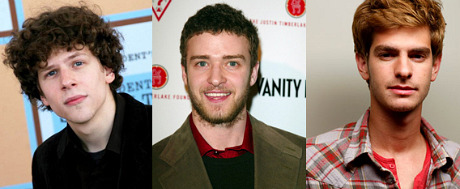
Longer Avatar
A slightly longer version of Avatar with a bit more than eight minutes of added footage will be released in theaters on 8.27 in both Digital 3D and IMAX 3D. One presumes that the Jake-and-Neytriri sex scene will be included. In a statement Cameron only said that the footage will contain “new creatures and action scenes.”
Cameron told me at a Santa Barbara Film Festival gathering last February that he and 20th Century Fox believed that Avatar could have kept going and going if it hadn’t been for 3-D theatrical commitments made to Tim Burton‘s Alice in Wonderland.
Carson’s Hopper Doc
There’s a “Cinefamily” screening tomorrow night at L.A.’s Silent Movie theatre of L.M. Kit Carson and Lawrence Schiller‘s The American Dreamer, a 1971 doc about the late Dennis Hopper. The 90-minute feature, which hasn’t been seen in eons, will begin at 9:30 pm. (Following a 7:30 pm showing of Easy Rider.) It’s the kickoff attraction for Cinefamily’s Hopper tribute series.
Carson will regale with Hopper stories after the show ends, or roughly around 11 pm. I wrote Carson and asked for a sample. He wrote back with the following: “Hopper’s 50th birthday hit while we were shooting Texas Chainsaw Masaacre 2 in Texas in May ’86, and on the birthday party night Hopper insisted on cutting the cake with a chainsaw — laughing and shouting ‘gotcha 5-0!’ I don’t think Dennis ever thought he’d actually die.”
“The wild, unexpected success of Easy Rider ushered in what is now seen as one of the most significant turning points in film history, making pathologically rebellious Dennis Hopper an unlikely King Of Hollywood for a day,” the notes read. “Incredibly, that day was filmed — and not just filmed, but captured by two innovative and inventive filmmakers. Co-directed by L.M. Kit Carson and Lawrence Schiller, The American Dreamer is many things: an insightful document of a complex artist in the midst of his creative process, a self-reflective exploration and explosion of verite filmmaking tropes, and a playful and entertaining snapshot of the private life of one of Hollywood’s most eccentric stars at the peak of his newly found fame.
“Hopper boldly allowed access to his crazy life in all its aspects: firing his rifles off in the desert, editing The Last Movie, stripping naked and walking through downtown Taos, New Mexico, pontificating about art and life, and holding forth guru-like to a room full of naked women. Fortuitously timed, fantastically made, and virtually unseen, The American Dreamer is the great ’70s film doc you always wished existed.”
Asking
If anyone has PDFs of the scripts for (a) David Guggenheim‘s Safe House, the Denzel Washington project, and (b) Dustin Lance Black‘s Electric Kool-Aid Acid Test, which Gus Van Sant will direct, please send along. Thanks.
Handles
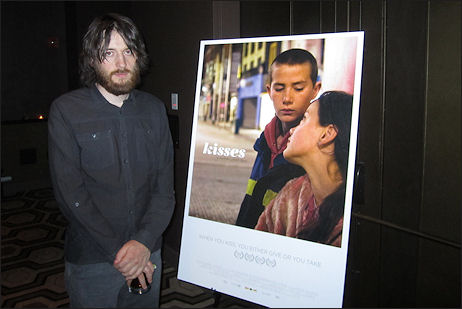
Kisses director Lance Daly after Tuesday night’s screening at the Tribeca Grand. Here again is my review.

I’ve been having problems with my left eye due to screen brightness. Hours and hours of writing each day is causing my left eye to get red and puffy. (The right eye is feeling left out.) So I’ve been (a) turning the screen brightness down and (b) wearing these green glasses while I write. It helps. It definitely feels less stressful.

One of the things that Brooklynites love about the L line is its tendency to run even slower than usual (and that’s saying something) when it’s really hot or really cold outside. This was taken at the height of rush hour yesterday morning. The cars were jammed tight and everyone was fuming because of the L line’s tardiness. It’s the worst subway line in the world. People offer vulgar gestures, corrrectly, to the driver as the train pulls in.

Dutch soccer fans on Soho’s Grand Street last Tuesday evening.
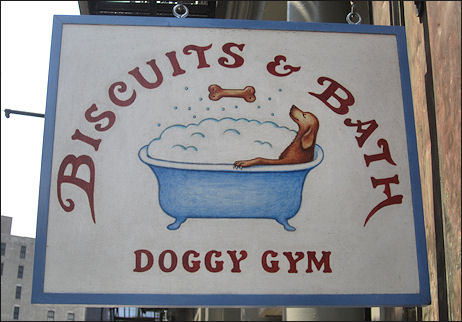
Poor Little Suddenly
From a home-video perspective, Suddenly (’54) is one of the most shat-upon little movies of all time. A moderately decent political-assassination thriller with Frank Sinatra as a psycho bad guy, it’s been in the public domain for decades, and has always looked gray, hazy and diminished. Until a year ago, I mean, when Legend Films put out a slightly better looking b & w version. Now it has a bluish tint, and is more sharply defined.
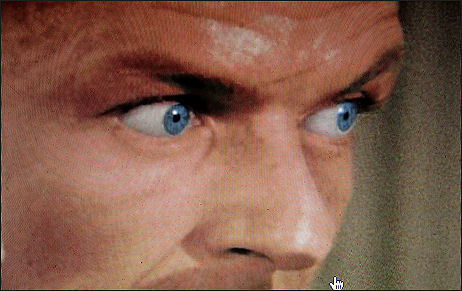
The Legend guys also included a colorized version that corrected the legendary error made by the bozos at Hal Roach Studios when they put out a colorized VHS in which Sinatra’s eyes were brown.
“In 1959, five years after the release of Suddenly, a novel was published which had a remarkably similar ending,” the Wikipedia page says. “This was The Manchurian Candidate written by Richard Condon, a former Hollywood press agent recently turned novelist. His book also features a mentally troubled former war hero called Raymond Shaw who, at the climax, uses a rifle with scope to shoot at a presidential candidate. Because of such strong similarities, it is now thought that Suddenly was one inspiration for Condon’s Manchurian Candidate.”
In the late ’70s Suddenly costar Sterling Hayden (who lived in my home town of Wilton) told me that they made Suddenly before Sinatra’s big comeback in From Here to Eternity. (Hayden presumably meant before FHTE opened in August 1953, although he might have meant before Sinatra won his Best Supporting Actor Oscar in early ’54, since Suddenly opened in October 1954.) Even though Sinatra’s career was in a “down cycle,” as Hayden put it, he “still had the old kezazz.”
Each and everyone of us has to bring that old kezazz to our lives each and every day, and if we fail to do that on a consistent basis then we’re basically dead. I don’t have as much kezazz as I could right now, but at least I feel guilty about it and intend to rev up and get going later today.
Try, Try Again
One of the best analysis pieces I’ve ever posted to this column (and we’re talking literally thousands of items and stories since HE’s August 2004 launch) was my High Noon vs. Rio Bravo thing, which I wrote about three years ago. I’m very proud of having made it clear to God and Peter Bogdanovich and Quentin Tarantino and all the other Bravo cultists out there why I feel Howard Hawks‘ 1959 film has, okay, some merit (it’s a half-decent film) but doesn’t hold a candle to Fred Zinneman‘s 1952 classic.
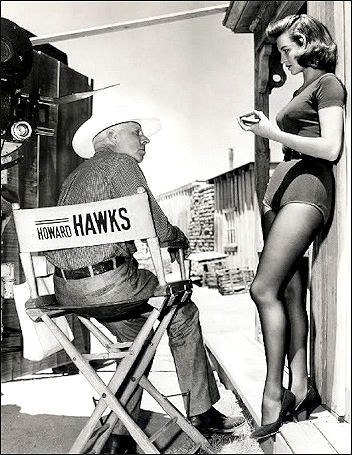
Howard Hawks had to know that making a romantic couple out of the hulking 51 year-old John Wayne and the doe-like, rail-thin 26 year-old Angie Dickinson was ludicrous, but I think he hired her anyway because of her great gams. And I think she knew this.
I just re-read the article and man, it really feels good when you discover that a semi-oldie reads clean and straight and true.
But in reading another well-written Rio Bravo analysis piece — actually a Rio Bravo vs. El Dorado thing, written a year ago by G.A. de Forest — it hit me that my ’07 article overlooked a huge aspect of Rio Bravo history, which is that Hawks more or less remade it twice — as El Dorado and Rio Lobo.
And so the obvious question: how good or classic or what-have-you can Rio Bravo be if the director not only decided five or six years later that he could improve upon it, but acted upon this notion not once but twice (with remakes #2 and #3 only four years apart), and using the same lead actor (John Wayne) in all three versions? And then admitting later on that the third version was shite?
Did Fred Zinneman feel the need to remake High Noon? Not as far as I know. We know for sure that he never did. Could it be that Zinneman felt it was good enough and didn’t need an upgrade? Uhm, probably. Does anyone think there might have been a reason why Hawks felt a need to remake Rio Bravo twice? I’m just spitballing, but the obvious conclusion is that he simply didn’t think Rio Bravo was “good enough,” to borrow from the Hawks lexicon.
“Rio Bravo, for ill-defined reasons, is the more generally admired by critics,” de Forest wrote. “Hawks specifically remade it because he believed he could improve on the first version, and then believed he had. I too, maybe because [I’m] a child of the Sixties, have always preferred El Dorado, though having just seen Rio Bravo again and giving it proper attention, I appreciate its niceties more than before.
“Hawks knew what he was doing in remaking it…[and] by most measures El Dorado is a less compromised piece of filmmaking. Maybe simply to give the ensemble cast more on-screen time, there is a conscious insert in Rio Bravo where singing stars Dean Martin and Ricky Nelson get to do their thing — Dean crooning a cowboy song — ‘My Rifle, My Pony, and Me’ — with less C & W feel than anyone since Roy Rogers. Ricky bats his thick eyelashes and heavy lids for the girls rather irritatingly throughout, and almost pouts his more-generous-than-Elvis lips. Walter Brennan comes close to self-parody with his incessant cackling.
“On top of this, the original is far too wordy, especially for a western — courtesy of the screenplay by highly cultured Hawks favorites Jules Furthman and Leigh Brackett.”
I really think this settles it once and for all. All those Bravo groupies need to stand up, man up and explain clearly and concisely how a film that its own director felt a need to remake twice is somehow superior to a single, stand-alone western that its co-creator (the other being Carl Foreman) never re-thought or re-made. Because it can’t be done. I knew about the remakes all along, of course, but now that I’ve re-thought everything and re-read the ’07 article and jumbled it all around, I now feel — in my own mind, at least — that the High Noon vs. Rio Bravo debate is over and done with, and the bitches have scattered.
Only If You Notice
I’m reminded of Jean Luc Godard‘s intriguing assessment of Rio Bravo, which is basically that it’s a better film than High Noon because the exceptionally good things in Rio Bravo can be ignored, and therefore may be unnoticable to a good-sized portion of the audience.
“The great filmmakers always tie themselves down by complying with the rules of the game,” Godard wrote. “Rio Bravo is a work of extraordinary psychological insight and aesthetic perception, but Howard Hawks has made his film so that the insight can pass unnoticed without disturbing the audience that has come to see a Western like all others. Hawks is the greater because he has succeeded in fitting all he holds most dear into a well-worn subject.”
I hold Godard’s theory in much higher regard than I do Rio Bravo. But I’m now asking myself which films of the last few years have lived up to Godard’s standards in this regard? Which recent movies, in other words, have delivered escapism by way of same-old-shit genre cliches (over and over and over again) while at the same time exciting and arousing the highbrows in such a sleight-of-hand way that Joe Popcorn, dumbass that he is, doesn’t even realize that a double-tracking thing is happening?
Principles
The initial title of Tuesday’s Lindsay Lohan post was “Throw The Key Away.” I wrote this on my iPhone early Tuesday evening while waited for a screening of Kisses to begin at the Tribeca Grand. The thought was “this woman has shown herself to be all but hopeless and needs to be slapped awake or she’ll be dead in ten or fifteen years, so don’t slap her on the wrist — hit her hard and pretend to throw away the key. Maybe that’ll get through.”
So the headline didn’t quite say it. But it was close, and sometimes you just need to go with what seems right before the screening begins.
After thinking things through the next morning I decided that I had to plop in a new title. Lilo needs to live and breathe and create and have a future. The point of pretending to throw away the key was to wake her up to the point that she might start to consider that she’s Errol Flynn-ing and Tallulah Bankead-ing and needs to turn it around. So I went with “The Crowd Roars” — generic but workable.
In response to which a couple of HE readers complained, saying that I lacked the stones to stick to the original headline. I responded as follows:
“I can and will change anything I want, whenever I want, if and when the mood changes or suits or whatever. I am the Lizard King. I can do pretty much anything. And it’s all about keeping things in flux, being adaptable, being open to whatever tremors or instincts or subliminal urges occur. I’m not the managing editor of the Kansas City Star in 1957 with a deadline approaching and final edits being applied downstairs before the presses roll. This is a fluid and sometimes cantankerous Thelonious Monky jazz column. I always reserve the right to tweak, modify, edit, change, add and, yes, sometimes, if the urge is strong or persistent enough, wimp out.
“Wimping out is part of human nature from time to time, so the freedom to wimp out is one of the tunes I might play — and so is the freedom to decide later on that I shouldn’t have wimped and thereafter a decision to restore whatever it is or was that I may have wimped out on in the first place.
“That said I stick to 97% of the stuff I put down initially. Make that 98%. Oh, and if I decide to edit this very post I’m writing right now then I will do that. Live with it or leave or whatever.”
